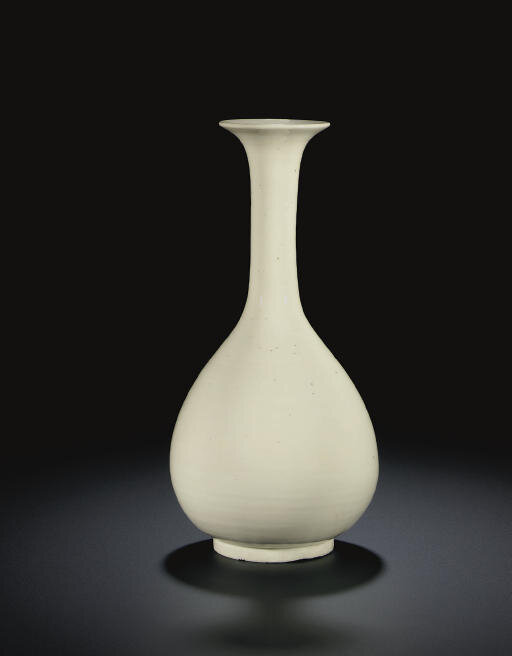A rare white-glazed stoneware bottle vase, Jin dynasty (1115-1234)
Lot 530. A rare white-glazed stoneware bottle vase, Jin dynasty (1115-1234); 9¾ in. (24.7 cm.) high. Estimate USD 30,000 - USD 40,000. Price realised USD 37,000. © Christie's Image Ltd 2008.
The elegant, pear-shaped body tapering to a tall, slender neck rising to a flared mouth, covered overall with a transparent glaze of ivory tone showing the finger grooves of the potting and falling just short of the knife-cut foot rim to reveal the fine white ware.
Exhibited: Baltimore, The Baltimore Museum of Art, Born of Earth and Fire, Chinese Ceramics from the Scheinman Collection, 9 September - 8 November, 1992, no. 57.
Note: The extraordinarily elegant form of this long-necked, pear-shaped, vase suggests close association with some of the ceramics admired by the Song dynasty court, both at Kaifeng and at Lin'an (Hangzhou). The profile of the vase is very similar to that of a Northern Song white Ding ware vase, with a carved lotus scroll around the body, which is preserved in the National Palace Museum, Taipei and illustrated in Catalogue of the Special Exhibition of Ting Ware White Porcelain, Taipei, no. 22. It is perhaps not surprising to find that the current vase and the National Palace Museum Ding ware vessel are also of similar height. The Guan ware kilns working for the Southern Song court near modern-day Hangzhou also produced vases of this form, as can be seen from the famous long-necked, pear-shaped, Guan ware vase in the Percival David Foundation illustrated by R. Scott in Imperial Taste - Chinese Ceramics from the Percival David Foundation, San Francisco, 1989, p. 41, no. 17. While the Guan ware vase is slightly smaller than the current white ware vessel, and appears to have a slightly thicker neck (probably due to the multiple layers of glaze), the overall shape is very similar.
The slenderness of the current vase's neck would have been very difficult to throw and to fire successfully, and when such a form was attempted at the Yaozhou kilns the neck was made somewhat wider and the mouth less flared, as in the case of the Yaozhou pear-shaped vase with carved peony scroll in the Kyusei Hakone Art Museum illustrated by G. Hasebe, ed., Sekai toji zenshu - Song, vol. 12, Tokyo, 1977, no. 49. The potter of a very rare 12th century pear-shaped Jun ware vase with purple splashes in the Percival David Foundation has rendered the lower part of the neck very slender, but, as it rises, the neck flares and the mouth rim is not everted. This vase is illustrated by R. Scott, op. cit., p. 38, no. 14. The majority of Jun wares, and indeed other Northern and Southern Song dynasty pear-shaped vases, have significantly wider necks, which would have made them easier to throw and less likely to sustain damage during firing.
A small number of finely potted white vases similar to the current example are known in published collections. One such vase, which shares a similar shape and size with the current vessel, was given to the Metropolitan Museum, New York in 1991 by Stanely Herzman in memory of his wife Adele. See S. Valenstein, The Herzman Collection of Chinese Ceramics, New York, 1992, p. 36, no. 25. A vase of similar shape, but of slightly smaller size and with a proportionally shorter neck, in the collection of the British Museum, London, is illustrated in Oriental Ceramics, The World's Great Collections, vol. 5, Tokyo/London/San Francisco, 1981, no. 55. A somewhat taller white vase in the Idemitsu Collection has a similar pear-shaped body to the current example, but the neck is only narrow at its lowest point, flaring thereafter to a flattened, rather than a curving, everted mouth. See Chinese Ceramics in the Idemitsu Collection, Tokyo, 1987, no. 84. Some variation in proportion can also be seen in two other vases. One was formerly in the collection of Mr. and Mrs. Eugene Bernat, and is illustrated by William Watson in Tang and Liao Ceramics, London, 1984, p. 96, no. 63. The other in the Kyusei Hakone Art Museum is illustrated in Mayuyama Seventy Years, vol.I, Tokyo, 1976, no. 637. A similar vase was also sold in these rooms, on 10 December 1987, lot 213.
Christie's. Fine Chinese Ceramics And Works Of Art, New York, 19 March 2008.

/https%3A%2F%2Fprofilepics.canalblog.com%2Fprofilepics%2F1%2F0%2F100183.jpg)
/https%3A%2F%2Fstorage.canalblog.com%2F03%2F02%2F119589%2F96711876_o.jpg)
/https%3A%2F%2Fstorage.canalblog.com%2F11%2F31%2F119589%2F94773502_o.jpg)
/https%3A%2F%2Fstorage.canalblog.com%2F20%2F83%2F119589%2F94772815_o.jpg)
/https%3A%2F%2Fstorage.canalblog.com%2F26%2F72%2F119589%2F75604929_o.jpg)
/https%3A%2F%2Fstorage.canalblog.com%2F59%2F60%2F119589%2F26458628_o.jpg)



/image%2F1371349%2F20240331%2Fob_a6f470_2024-nyr-22642-0857-000-a-large-black.jpg)
/image%2F1371349%2F20240329%2Fob_2f6b6c_854-1.jpg)
/image%2F1371349%2F20240329%2Fob_54ca74_114-1.jpg)
/http%3A%2F%2Fstorage.canalblog.com%2F77%2F04%2F119589%2F129856496_o.jpg)